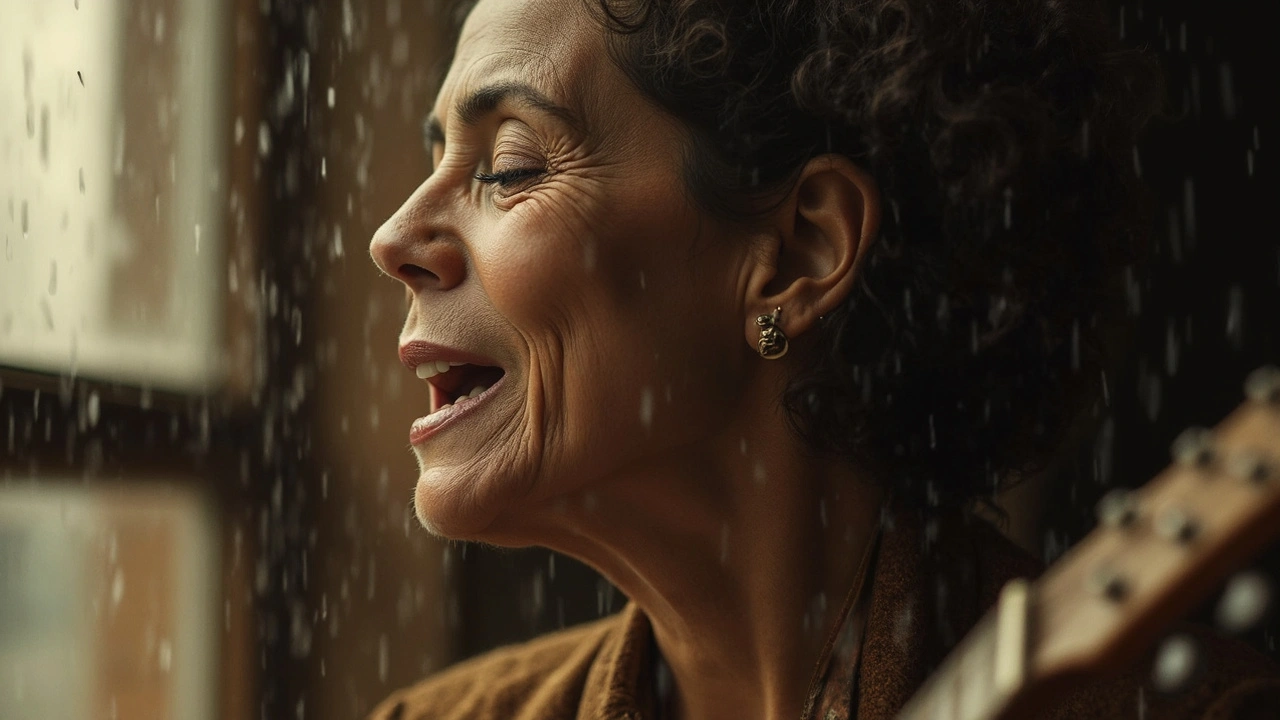Ever listen to a blues song and instantly feel like someone just read your mind? That’s the magic of blues—it cuts straight to what you’re feeling but can’t quite say out loud. No sugarcoating or fancy tricks. Just honest emotion, plain and simple.
The blues started with people who had a lot to get off their chest. From the cotton fields in the deep South all the way to smoky clubs in Chicago, it was always about real life and real stories. Hard times, heartbreak, tough breaks—blues musicians didn’t just write about them, they lived them.
If you want to get under the skin of blues music, start by listening for the raw voice and the bluesy guitar bends. These are the sounds that make you flinch and nod your head, usually without even realizing it. There’s a reason blues is the go-to soundtrack for bad days and late nights—it just gets it. And once you see how blues artists turn everyday struggles into unforgettable songs, you start to notice the emotion everywhere in their music.
- The Heart of the Blues: Why It Hits So Hard
- Voices and Guitars: How Sound Becomes Feeling
- Stories in Every Chord: Real Life in the Lyrics
- Iconic Artists Who Poured Their Soul Out
- Tips to Really Feel The Blues—Whether You Play or Listen
The Heart of the Blues: Why It Hits So Hard
If there's one thing everyone agrees on, it's that blues music hits you right in the gut. But why does it feel so real? The heart of blues is all about raw honesty. It grew out of the hard experiences of African American communities in the late 19th century—people used it as a way to deal with pain and express emotions that couldn't always be said out loud. This music wasn't about impressing anyone. It was about getting through the day.
There's a clear reason why blues sounds so different from other genres. It uses the "blues scale," which adds slightly off-pitch notes called "blue notes." Those bent notes make the music sound kind of sad, kind of hopeful, and totally human. It's like someone letting out a deep sigh after a rough day.
Sometimes, it helps just seeing the numbers:
| Blues Fact | Number/Year |
|---|---|
| First blues recordings | 1912 (by W.C. Handy) |
| Standard blues structure (bars) | 12-bar format |
| Peak mainstream popularity | 1940s - 1950s |
Blues lyrics don’t beat around the bush. The pain in these songs often comes from real struggles—poverty, heartbreak, racism, loneliness. But the magic is that blues isn’t just dwelling on what's tough. It’s about saying: "Life’s hard, but I’m still here." You hear a blues song, and you know you’re not alone.
If you ever sing or play blues, don’t worry about sounding perfect. What matters most is putting your real feelings into it—no filter, no pretending.
- Pick a line that means something to you.
- Let yourself feel it as you play or sing—messy is good.
- Don’t hold back; blues isn’t about notes, it’s about truth.
That’s why blues music still grabs people after more than a hundred years. It cares less about style and spotlight, and more about just laying it all out there.
Voices and Guitars: How Sound Becomes Feeling
You can’t talk about blues music without zooming in on the sound—the way the voice and guitar work together to punch you right in the gut. The secret sauce? Expression. Blues singers don’t hit every note perfectly, and that’s the point. Bessie Smith’s raw belting, Muddy Waters’ growl, or even modern players like Gary Clark Jr. twisting their vocals—you actually feel what they’re singing before the words even land.
It’s the same with the guitar. That crying, bending note? It’s not about technical skill, but about dragging a note out just long enough for the pain to set in. Blues guitarists use a ton of slides and bends—think of B.B. King’s legendary “Lucille” guitar, or Stevie Ray Vaughan’s wild but precise licks. If you grab a guitar and slide your finger up the string while slightly bending it, you’ll nail that classic blues sound. That wobble is pure feeling. It’s like every note is another layer of what they’re carrying inside.
Something unique in blues music is call-and-response. Sometimes, the singer throws out a vocal line, and the guitar talks back—almost like they’re having a conversation. This goes way back to African musical traditions and became super common in blues by the 1920s.
Here’s a handy breakdown of the common blues sounds and what they do:
- Vocal Distortion: Growls and raspy shouts make every line sound urgent and real.
- Bending Notes: Pushing or pulling guitar strings sends a note off pitch, adding a human touch.
- Slides: Sliding a glass or metal tube along the strings gives the guitar a voice of its own.
- 12-Bar Blues: Most blues sticks to a simple 12-bar chord progression, which makes the emotion—not fancy chords—the star.
According to a 2019 survey by the National Blues Museum, 78% of visitors said they connect emotionally to blues performances mainly because of the expressiveness in vocals and guitar work.
Whether you sing, play, or just listen, next time pay attention to how those voices and guitars don’t just fill your ears—they hit you right in your feelings. That’s the soul of blues music.

Stories in Every Chord: Real Life in the Lyrics
What makes blues music hit so deep? The tough stuff most of us try to dodge shows up front and center in the lyrics. It’s not just about catchy riffs or wild solos. Blues songs are basically real-life diaries put to music. Nothing’s off-limits—breakups, bad luck, tough jobs, even just feeling stuck. Legends like B.B. King said, “The blues was bleeding the same blood as me.” That sums it up: you hear a blues tune, and it sounds like someone’s living the same life you are.
Let’s break down why blues lyrics are different. They stick to straight talk. Take Robert Johnson’s famous line, “I went down to the crossroads, fell down on my knees.” He’s not hiding how desperate he feels—actually, he’s throwing it all out there. And if you listen to Muddy Waters, Willie Dixon, or Etta James, their stories always come from hard-earned experience, not made up for radio play.
Here’s what you’ll notice in strong blues expression through lyrics:
- Simple words with big impact: Most blues songs use plain language you’d hear at home or work.
- Repetition for feeling: You’ll often hear the same line twice, like in "Hoochie Coochie Man" or "Sweet Home Chicago," which makes the emotion hit harder each time.
- “Call and response” style: The singer shouts a line, and the guitar, harmonica, or even the crowd answers back. It keeps the music connected to real conversations.
- Personal stories turned universal: Blues artists sing about what actually happened to them, but anyone listening can relate.
Want some proof of just how real it gets? Check out this quick look at common themes in blues lyrics:
| Theme | Common Example |
|---|---|
| Hard Times | "Nobody knows you when you're down and out" |
| Heartbreak | "Baby please don't go" |
| Travel | "Sweet Home Chicago" |
| Work Struggles | "Nine Below Zero" |
Real talk—that’s what keeps blues history alive. The lyrics are simple, but the stories run deep. Listen for those everyday problems twisted into a catchy line and you’ll hear just how much life is packed into every chord.
Iconic Artists Who Poured Their Soul Out
When you talk about blues music and raw emotion, a few names keep popping up—and for good reason. These artists don’t just play notes; they lay everything on the table. Let’s break down what makes some of these blues icons unforgettable.
Muddy Waters didn’t just help shape Chicago blues—he pretty much defined how modern blues music should sound. His song “Mannish Boy” is basically a shout of confidence, even if you’re feeling down. Waters started out picking cotton and learned music by ear, which shows how blues isn’t about fancy technique—it’s about saying exactly how you feel.
B.B. King made his guitar, Lucille, practically sing. He lost both parents by age ten and spent years sharecropping before finding his break. If you’ve heard “The Thrill Is Gone,” you know what heartbreak actually sounds like. B.B.’s secret? Simple: don’t play a ton of notes—make every one count.
Robert Johnson is wrapped in legend. Folks say he sold his soul to play the guitar the way he did. Who knows what’s true, but his songs like “Cross Road Blues” pour out raw pain and longing. Johnson packed all his struggles—poverty, racism, rough living—straight into razor-sharp lyrics and haunting guitar lines.
Etta James was fierce. Her track “I’d Rather Go Blind” goes from smooth to raw in seconds. She grew up tough, moved through foster homes, and battled a lot of demons—her voice carried all of that and more. Etta didn’t just sing the blues, she lived them.
Even modern artists like Gary Clark Jr. keep that tradition alive. His performances feel as personal as any classic, and he’s inspired a whole new group to tap into those deep emotions that define blues music.
If you want to sum up why these artists matter, just remember: it’s not only about their technical skill. It’s about honesty. They put all their anger, rejection, hope, and grit right into the music. When people say the blues is "the truth," they’re thinking of these folks.
| Artist | Signature Song | Key Emotion |
|---|---|---|
| Muddy Waters | Mannish Boy | Pride |
| B.B. King | The Thrill Is Gone | Heartbreak |
| Robert Johnson | Cross Road Blues | Desperation |
| Etta James | I’d Rather Go Blind | Longing |
| Gary Clark Jr. | Bright Lights | Frustration |
So next time you listen to blues music, put yourself in their shoes. These artists didn’t hold back, and that’s exactly why their music still hits so hard.

Tips to Really Feel The Blues—Whether You Play or Listen
People sometimes think only artists get to experience the raw emotion of blues music, but honestly, anyone can feel it. Whether you’ve picked up a guitar or just popped in some headphones, you can really plug into that emotional power if you know how. Here’s how to go deeper with your blues experience, no matter your role.
- Listen Actively: Don’t just play blues music in the background. Grab a track—maybe something classic like B.B. King’s “The Thrill Is Gone” or Etta James’ “I’d Rather Go Blind.” Listen for details—the rasp in the voice, the slow drag of each note, and even the spaces where nothing is played or sung. Those silences are where a lot of the emotion comes through.
- Dig Into Real Stories: The best blues songs tell true stories—sometimes straight out of the artist’s own struggles. Research the backstories of famous tracks. For example, Robert Johnson’s legendary songs are tied to his own rough life and the myths surrounding him. Knowing these details makes the feeling hit harder.
- If You Play, Keep It Simple: Blues isn’t about cramming in a million fancy notes. It’s about digging into just a few, but really feeling them. Try playing a slow 12-bar blues progression on guitar or piano and focus on bending your notes and adding vibrato. Even a beginner can get that signature sound with some patience.
- Singing the Blues? Mean What You Say: Forget vocal perfection—channel what you’re actually feeling. Some of the greatest blues recordings are a bit rough around the edges because the singers just let it rip. It’s way more about emotion than technique.
- Join the Scene: If you ever get the chance, hit up a local jam session or blues night. Watching musicians interact in real time, trading solos and singing about everything from lost love to busted trucks, is the best kind of blues lesson you’ll get.
If you’re after a bit of data, check this out:
| Popular Blues Artist | Famous Track | Key Emotional Theme |
|---|---|---|
| Muddy Waters | Mannish Boy | Pride & Struggle |
| Billie Holiday | Strange Fruit | Sorrow & Protest |
| Buddy Guy | Feels Like Rain | Heartbreak |
One more tip—don’t be afraid to let yourself get a little uncomfortable. Blues music is supposed to stir something up. Whether it’s old heartbreak or that weird feeling you can’t put a name on, just lean into it. That’s when you really start to get the blues—not just hear them.

